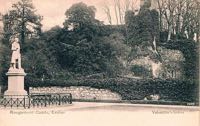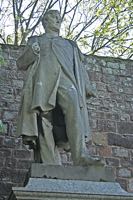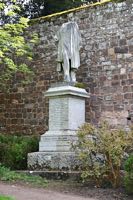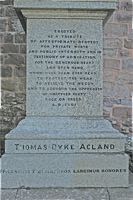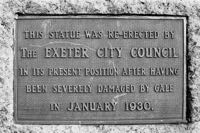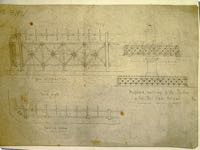
Statue of Thomas Dyke Acland
Page updated 21st July 2017
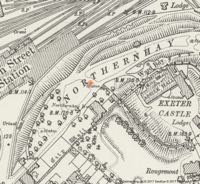 Sir Thomas
Dyke Acland
(1787-1871), of Killerton House, was a Tory MP
for Devon over a period of 45 years. Elected to Parliament on 15
October 1812, he adopted a more liberal line than his compatriots. He
retired from the house in 1831, only to be elected again in 1837, and
finally retire in 1857. Acland became a generous benefactor and
supported many charities.
Sir Thomas
Dyke Acland
(1787-1871), of Killerton House, was a Tory MP
for Devon over a period of 45 years. Elected to Parliament on 15
October 1812, he adopted a more liberal line than his compatriots. He
retired from the house in 1831, only to be elected again in 1837, and
finally retire in 1857. Acland became a generous benefactor and
supported many charities.
In May 1844, Acland announced, to an interested House of Commons, that he had left Exeter at 5pm that afternoon and was speaking to the House at 10pm the same day, using the new railway from Exeter. Formerly, it had taken him sixteen to twenty hours by stage coach.
Acland's are recorded in Devon as far back as the 12th century. The Acland family have been major Devon landowners for generations and resided at Killerton House, just outside Exeter. During the Civil War, the Acland's were noted Royalists.
The Unveiling
The statue is the work of E B Stephens, the Exeter born sculptor; the railings around the statue at the time of the unveiling were by Garton and King. The railings were removed in 1895 on the grounds that the spikes were a danger to children. It was paid for by public subscription, with a minimum donation of £5.
It was unveiled in October 1861, when the crowd gave a cheer at the mention of his name during one of the speeches. It had been eagerly anticipated by the great and the good, and on the same day, John Gendall placed an advert, in the Flying Post, offering engraved prints from a photograph, suitable for framing, for 7s 6d. after the ceremony, the dignitaries walked to the New London Inn fro dinner. Not all were enthused by the statue and the Western Times published an editorial questioning the placing of the statue on the grounds that "Sir Thomas Acland's merits are those of a large hearted but not heroic nature." He was deemed to have made political mistakes, and although an honest man, he had been a vacillating politician that had harmed the country.
On the front of the pedestal is inscribed:
"Erected as a tribute of affectionate respect for private worth and public integrity and in testimony of admiration for the generous heart and open hand, which have been ever ready to protect the weak, to relieve the needy, and to succour the oppressed of whatever party, race or creed. AD 1861."
A year after the unveiling an admirer of the statue had this poem published in the Western Times.
THE ACLAND STATUE
On being told to look at the Statue on Northernhay, Exeter while its original was present.
Nay ! bid me not regard the chiselled stone
That shows the outline of the form alone.
What limner's art, what sculptor's power, can trace
The kindly smile that beams on Acland's face ?
What artist's hand to marble can impart
The active love that warms his generous heart ?
There stands the archetype ! while it I see,
No dumb insentient effigy for me
“Look at the statue ?" pooh thou tasteless elf—
Look at Sir Thomas ! there's the man himself!
J. G. M.
Knocked about by weather
The statue has had an unlucky life, suffering damage from time to time. Stephens was requested to replace a finger, that had broken off during a gale in October 1877. It was moved to its present position, under the city wall, after it sustained damage when an elm knocked it off its pedestal, during a particularly vicious northerly gale, which hit Northernhay Gardens in March 1930. It was repaired by Easton's of Northernhay Street, at a cost of £100, and moved to a new position in September 1930. The statue had lost its head when I first went to photograph it in 2004. The parks department have since managed to marry the good gentleman's head to his body.
Sources: The British Newspaper Archive
│ Top of Page │
